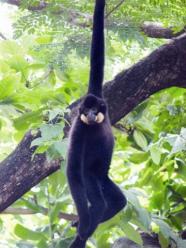New Ape Species Discovered
Posted by: Loren Coleman on September 21st, 2010
The Yeti hasn’t been formally recognized. A new gorilla or chimp species hasn’t been found in deepest Africa. A new species of orangutan has not issued from Asia. But the breaking news today that a new species of ape, indeed, that a new species of gibbon has been recognized, is quite remarkable on its own merits. Like orangutans, gorillas, chimpanzees and bonobos, gibbons belong to the apes, man’s closest relative.
German scientists have announced on September 21, 2010, that they had discovered a new rare and endangered ape species in the tropical rainforests between Vietnam, Laos and Cambodia. It has been identified by its distinctive song.

The new type of crested gibbon (photo above) is named the northern buffed-cheeked gibbon (Nomascus annamensis), noted the statement from the German Primate Center (DPZ) said.
“The discovery of a new species of ape is a minor sensation,” said Christian Roos from the DPZ. “An analysis of the frequency and tempo of their calls, along with genetic research, show that this is, in fact, a new species.”
The distinctive song “serves to defend territory or might even be a precursor of the music humans make,” the statement added.
The DPZ said that the male of the new species is covered with black fur that appears silver in sunlight, while the females are orange-beige. The male’s chests are brown and male cheeks are deep orange-golden.
The range of the crested gibbons is in an area enclosing Vietnam, Laos, Cambodia and southern China. Scientists had assumed there were six different species but the recent discovery takes the number to seven. (Various other crested gibbons are pictured below.)



Many species number only around 100 individuals, said Roos. Scientists currently have “absolutely no idea” how many of the new species might be alive, but are conducting further study to determine this, he told AFP.
“Only if we know where which species is found and how many individuals there are can we start with serious conservation actions,” summarized DPZ’s Christian Roos.
News of the discovery was published in the Vietnamese Journal of Primatology.
About Loren Coleman
Loren Coleman is one of the world’s leading cryptozoologists, some say “the” leading living cryptozoologist. Certainly, he is acknowledged as the current living American researcher and writer who has most popularized cryptozoology in the late 20th and early 21st centuries.
Starting his fieldwork and investigations in 1960, after traveling and trekking extensively in pursuit of cryptozoological mysteries, Coleman began writing to share his experiences in 1969. An honorary member of Ivan T. Sanderson’s Society for the Investigation of the Unexplained in the 1970s, Coleman has been bestowed with similar honorary memberships of the North Idaho College Cryptozoology Club in 1983, and in subsequent years, that of the British Columbia Scientific Cryptozoology Club, CryptoSafari International, and other international organizations. He was also a Life Member and Benefactor of the International Society of Cryptozoology (now-defunct).
Loren Coleman’s daily blog, as a member of the Cryptomundo Team, served as an ongoing avenue of communication for the ever-growing body of cryptozoo news from 2005 through 2013. He returned as an infrequent contributor beginning Halloween week of 2015.
Coleman is the founder in 2003, and current director of the International Cryptozoology Museum in Portland, Maine.










I’m trying to get my head around the idea that Gene Autry and the Jonas Brothers belong to different species because they have different songs. Those splitters are going crazy!
Only 100? Is that enough to maintain a viable population?
I hope we can save the little buggers.